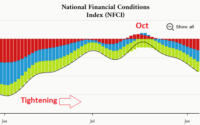Federal Reserve’s Post-Crisis Policies Decoupled Asset Prices from Risk, Creating Enormous Risks for U.S. Economy
WASHINGTON, D.C.— Dennis M. Kelleher, Cofounder, President, and CEO, issued the following statement in connection with a report on the Federal Reserve’s actions decoupling asset pricing from risk from 2008-2022 and creating systemic instability. The report comes ahead of the upcoming Federal Open Market Committee (FOMC) meeting on January 31.
“While most of the media coverage of the Fed is focused on inflation and the hard turn in monetary policy, it is important to understand how the Fed’s own unprecedented policies over the last 14 years have significantly contributed to – if not caused – many of the issues they are now trying to address. Our report details how these policies decoupled the relationship between asset prices and risk and ignited a historic borrowing and debt binge. These are now being unwound as the Fed quickly and forcefully reverses course, creating serious risks that could result in financial and economic instability. Put differently, the Fed is in many ways fighting problems of its own creation. And considering the scale of the problems, it is very difficult to solve without some damage.
“Since the 2008 financial crisis, the Fed has focused more on short-term objectives, failing to prioritize sensible long-term risk management and even ignoring some of its basic principles. It has been very concerned with inflation expectations becoming entrenched – first expectations of low inflation prior to the pandemic and now high inflation – but it wasn’t concerned with the entrenchment of expectations around its ultra-accommodative policies. Similarly, it consistently failed to see – or appropriately consider – itself as a source of major risks.
“As a result, rates were near zero or at historic lows between the 2008 Crash and the current fight against inflation, and the Fed’s balance sheet expanded immensely to nearly $9 trillion – nine times as large as before the 2008 Crash. With expectations of consumers, businesses, and even the U.S. Government around cheap debt and of financial markets around readily-available liquidity being fully entrenched, there was an historic increase in the amount of debt and a decoupling of the prices of financial assets from their underlying risks. This dynamic was put into overdrive by the Fed’s outsized actions in response to the 2020 pandemic that flooded trillions of dollars into markets, which led to indiscriminate risk taking by pushing investors into riskier assets. Indeed, the Fed left no margin for error, continuing its immense asset purchases for two full years after the 2020 pandemic-related stress, despite glaring warning signs including from credit markets and rising inflation.
“As monetary policy rapidly shifts to a potentially new era that will begin with a much higher federal funds rate compared to the extended period of near-zero policy, the risk-taking and debt buildup from the prior era will pose significant financial stability risks that threaten to cause catastrophic damage. Without undertaking a frank, unbiased, and data-driven assessment of the Fed’s prior actions, we risk repeating the same mistakes and putting the U.S. in a series of highly abnormal boom-and-bust cycles that are almost entirely driven by monetary policy.”
You can find the Report here.
[ad_2]
Source link


